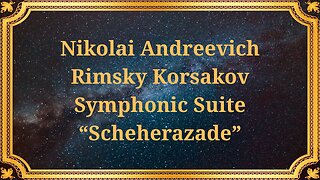Premium Only Content

Igor Stravinsky L'Histoire Du Soldat
#classicalmusic #IgorStravinsky #LHistoireDuSoldat #musicalcomposition #soldierensemble #jazzmusic #spokenword #theatermusic #musicalart
Publication date 1950
Leonard Bernstein; Boston Symphony Orchestra
Igor Stravinsky, one of the most innovative and influential composers of the 20th century, created a wide range of works that continue to resonate with audiences to this day. One of his most unique and striking compositions is undoubtedly "L'Histoire Du Soldat" (The Soldier's Tale).
Composed in 1918, the piece is intended to be a combination of music, dance, and spoken word that tells the story of a soldier who sells his soul to the devil in exchange for a magical book that can answer any question he desires. Through the journey of the soldier, Stravinsky uses a vast range of musical styles, including jazz and ragtime, to create a distinct musical language.
The work is scored for a small ensemble of seven instrumentalists: a clarinet, bassoon, trumpet, trombone, violin, double bass, and percussion. This is considered a "soldier's ensemble," since it's the same configuration of instruments that would be available during wartime when many soldiers were drafted into ensembles to play music for their comrades. The unique nature of this ensemble provides a bright and evocative sonic palette that’s different from other compositions of the time.
"L'Histoire Du Soldat" is made up of eleven movements, each brilliantly crafted by Stravinsky to capture the different emotions and moods of the story it tells. The music ranges from jaunty and upbeat in the first movement to slow and reflective in the ninth. The spoken parts of the piece are delivered by a narrator and are interspersed with the music, creating an overall atmosphere of theatricality and drama that further heightens the emotional impact of the piece.
One of the most fascinating aspects of "L'Histoire Du Soldat" is how it merges different musical styles to create a unique and distinctive sound. Stravinsky's use of jazz and ragtime elements undoubtedly anticipates later styles, such as Gershwin's Porgy and Bess, and represents a revolutionary approach to classical music composition. The work's use of tonality also breaks away from conventional Western music styles and finds its roots in Stravinsky's interest in Russian and Eastern European folk music.
Despite its initial mixed reception, "L'Histoire Du Soldat" is now considered one of Stravinsky's most popular works and a hallmark of 20th-century musical composition. Its combination of spoken word, dance, and music, coupled with the emotional journey of the soldier as he faces the consequences of his deal with the devil, makes
You have the opportunity to support the channel https://destream.net/live/RadSiarAl/donate
-
 41:38
41:38
Classical music_Music Inspiration
20 days agoNikolai Andreevich Rimsky Korsakov Symphonic Suite “Scheherazade”
1381 -
 LIVE
LIVE
Viss
2 hours ago🔴LIVE - How to Win The Battleground with Tactics, Precision, & Knowledge!
171 watching -
 DVR
DVR
Sean Unpaved
1 hour agoNo Respect for Hurts, Gillis Goes Wild, MLB Trade Deadline Buzz, & CFB's Big Question
7.35K -
 1:04:54
1:04:54
Timcast
2 hours agoCNN SHOCKED Trump APPROVAL Went UP Following Epstein Scandal
112K80 -
 LIVE
LIVE
Barry Cunningham
13 hours agoMUST WATCH: KAROLINE LEAVITT HOSTS WHITE HOUSE PRESS CONFERENCE!
2,127 watching -
 10:51
10:51
Adam Does Movies
2 hours ago $0.19 earnedI Know What You Did Last Summer - Movie Review
4.59K1 -
 LIVE
LIVE
The Tom Renz Show
1 hour agoThe DOJ Does Something! They Sue to Keep Fluoride in the Water???
199 watching -
 1:58:42
1:58:42
The Charlie Kirk Show
2 hours agoDefund NPR + New War in Syria? America's Military Restored| Ashkar | 7.17.25
31.1K4 -
 1:39:35
1:39:35
The Mel K Show
2 hours agoMORNINGS WITH MEL K - Redefining the Threat We Face: Who are our Allies and Adversaries Really? 7-17-25
21.4K2 -
 40:09
40:09
The Rubin Report
3 hours agoListen to ‘The View’ Crowd Gasp as Whoopi Melts Down Over Mark Cuban’s Mild Criticism of Dems
70.9K64